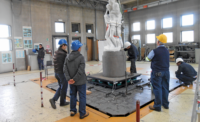Upgrading ventilation systems in older buildings to conform to new 2008 New York City building codes can significantly lower energy costs. A building designed under 1968 codes might have targeted 140 cfm of kitchen ventilation where 2008 code now requires only 25 cfm, Zuluaga explains.


“Ventilation drives energy use in these older buildings,” Zuluaga says. “Mushroom fan systems suck a ton of air out of these buildings and that makes the boiler work harder.”
Ventilation retrofits at Echo Apartments, built to the 1968 code, included air sealing ducts and installation of balancing dampers. The roof fan was upgraded with a Vari-Green electrically commutating motor, which is significantly more efficient than a standard mushroom fan, Zuluaga explains. “It is a beautiful fit and a great payback.”
Replacing EquipmentReplacing boilers and chillers with new equipment generally does not make sense unless the equipment is ancient or can’t be controlled well, von Braun explains.
At 200 East End Avenue, a 166-unit, 255,000-sq.-ft. co-op in Manhattan, two old, inefficient steam boilers providing hydronic heating, domestic hot water and steam for the chiller are being replaced with a natural gas fired hydronic boiler. The building’s aging 350-ton single-stage absorption chiller is also being replaced with two 200-ton direct fired chiller/heaters that make chilled water in the summer and complement the boiler in the winter.
Separate natural gas-fired hot water boilers supplying domestic hot water will result in substantial energy savings, Scorrano explains. Currently, the existing boilers are run all year to supply domestic hot water.
The Winston Churchill, a 333-unit postwar co-op at 2500 Johnson Avenue in the Bronx, replaced its 600-ton single stage absorption chiller, which had mechanical problems, with two 275-ton natural gas fired two stage absorption chillers. New cooling towers with variable frequency drives (VFD) on the fan motors and pumps and two condensing hot water boilers were also installed.
The building’s two 500-horsepower oil-fired boilers, found to be in good conditioned, were retained and converted to natural gas. Some work was done on the burners and controls.
“Currently the building is saving about one-third of its overall fuel consumption (half in summer and around 15 percent in the winter) which equates to about $200,000 annually,” Scorrano says.
Water and LightingOther recommended strategies include lowering the temperature of domestic hot water heaters and installing low-flow fixtures to save energy and water. Payback is generally less than two years.
Retrofitting lighting in common areas lit 24 by 7 is relatively inexpensive and has a relatively quick payback. Zuluaga does a lot of upgrades to bi-level lighting fixtures with dimmable ballasts and occupancy sensors in areas like stairwells that need lighting at all times.
Blended PaybacksRetrofit strategies generally consider combinations of solutions. Building owners budgets and priorities determine which retrofit packages are selected for implementation.
Wilson Suarez, senior energy engineer at Community Environmental Center, Long Island City, N.Y., recently completed work on a 158-unit coop in Manhattan where the board was quite progressive. “They asked for things like a cogeneration system,” he says.
Audit analysis focused on cogeneration in conjunction with other strategies, such as bi-level lighting for common areas, an energy management system, energy efficient appliances, timers on exhaust fans and measures to restrict hot water usage. Total project cost was $800,000 with a 7-year payback before $170,000 of incentives from NYSERDA Multifamily building program, Suarez explains.
A similar building focused on replacing leaky, single pane windows, Suarez says. Other modifications recommended were along the lines of the first building. The cost for retrofits for this building was $900,000 with a 12-year payback before $130,000 NYSERDA incentives.



Post a comment to this article
Report Abusive Comment